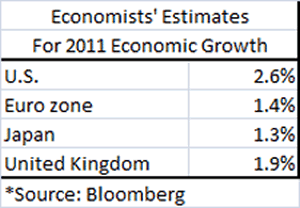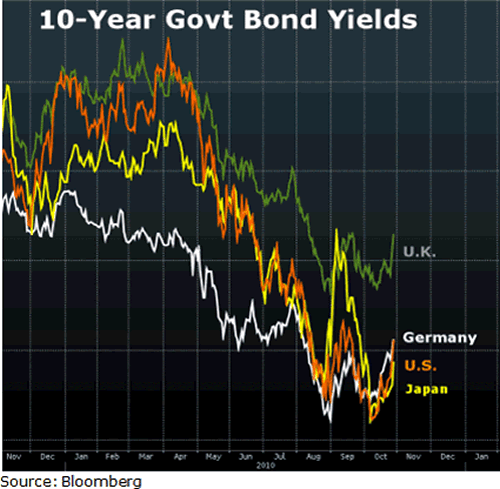Results 1 to 1 of 1
Thread Information
Users Browsing this Thread
There are currently 1 users browsing this thread. (0 members and 1 guests)
-
12-20-2010, 12:08 AM #1Senior Member


- Join Date
- May 2007
- Location
- South West Florida (Behind friendly lines but still in Occupied Territory)
- Posts
- 117,696
U.S. Economy Muddling Through, More Crises, More Global Risk
U.S. Economy Muddling Through, More Crises, More Global Risk Aversion Ahead
Interest-Rates / Global Debt Crisis
Dec 19, 2010 - 06:40 AM
By: Bryan_Rich
For the better part of 2009 and for the second half of 2010, the worldâs focus has been on how dreadful things look in the U.S. and how great the opportunities are said to be everywhere else.
But despite all of the anti-dollar and anti-U.S. policy sentiment that has proliferated around the world, apparently the financial markets havenât felt the same way!
In fact, heading into the final two weeks of the 2010, U.S. assets have been a harbinger of investment performance.
Longer term the story is the same â¦
Year-to-date, the dollar index is up 3 percent. Ten-year Treasuries have gained 4.3 percent. And the S&P 500 is up more than 11 percent.
Meanwhile, investors lost 1.9 percent in Brazilian stocks ⦠lost 2.2 percent in Japanese stocks ⦠and lost 11.6 percent in the Chinese stock market index.
Among global currencies, the dollar has held its own, performing right in the middle of more than 70 global currencies in 2010, and in positive territory against a basket of major currencies.
Going into 2011, the outlook for next year continues to argue for U.S. assets outperforming those of several other major markets.
Take a look at the GDP estimates for 2011 in the table below â¦

While global growth is sluggish and the outlook for meaningful improvements looks bleak, in a world with few options, muddling along doesnât look so bad. And the U.S. is doing just that, due in large part from the aggressive stimulus policies.
But Will It Continue?
There has been a lot of focus on the sharp rise in U.S. interest rates during recent weeks. And the mediaâs explanation of this activity has included two opposing viewpoints that portend two diverging outlooks for the U.S. economy:
The argument for a better economic outlookâ
The improving U.S. economic data, combined with the stimulative monetary and fiscal stance, will lead to better U.S. growth than what has been anticipated. Therefore rates are rising in view of a strong 2011!
The argument for a gloomy economic outlookâ
Given the aggressive monetary and fiscal stance in the U.S., the bond markets here are beginning to take the punishment â ultimately driving rates higher and higher, just like in Europeâs weak countries.
Weâll likely find that neither of those arguments is valid.
Take a look at this chart of 10-year government bond rates that include the U.S., euro zone, Japan and the U.K. You can clearly see this is not only a move in U.S. government interest rates, itâs a global rate surge.

The fact is, big investors have been riding the government bond marketsâ returns for the better part of the year. And the recent aggressive rise in rates has all of the trappings for when these same investors book their profits into the year-end, pushing bond prices down and yields up.
In a global economic environment defined by deleveraging and depressed global demand for the foreseeable future, rates are in a historically low range. And I believe theyâll likely continue to oscillate in that range until the outlook for a sustainable recovery arrives.
And donât expect that to come anytime soon. Already Bill Gross, the worldâs biggest bond fund manager is said to be accumulating bonds at the current levels, looking for another retreat in rates.
So runaway interest rates probably wonât be the story for 2011, but hereâs what youâll likely see â¦
More Crises, More Global Risk Aversion
The evidence is growing in Europe that this current act of government rescue isnât working. This week Moodyâs cut Irelandâs credit rating five notches. Plus it put Greece and Spain on review for a downgrade.
Now the one left holding a growing bag of sour sovereign debt in those three, as well as in the other weak euro countries, is the European Central Bank (ECB). And the ECB is publicly showing concern about taking a haircut on such âinvestmentsâJoin our efforts to Secure America's Borders and End Illegal Immigration by Joining ALIPAC's E-Mail Alerts network (CLICK HERE)


 LinkBack URL
LinkBack URL About LinkBacks
About LinkBacks




 Reply With Quote
Reply With Quote

Giant Laken Riley Billboard Truck Circles Bidens Speaking Venue...
04-23-2024, 09:52 PM in Americans Killed By illegal immigrants / illegals